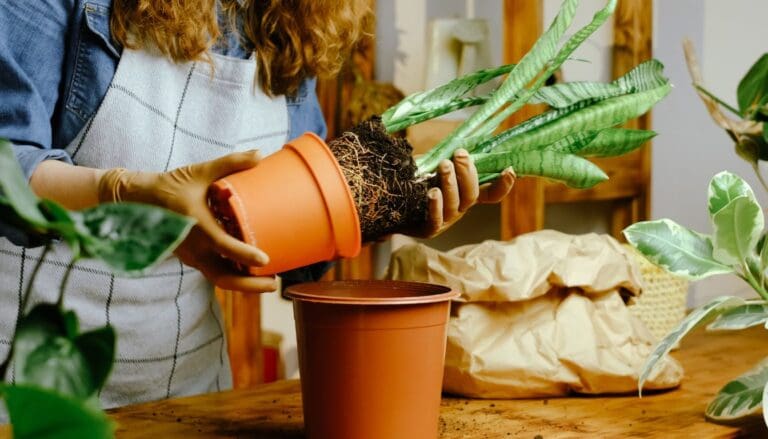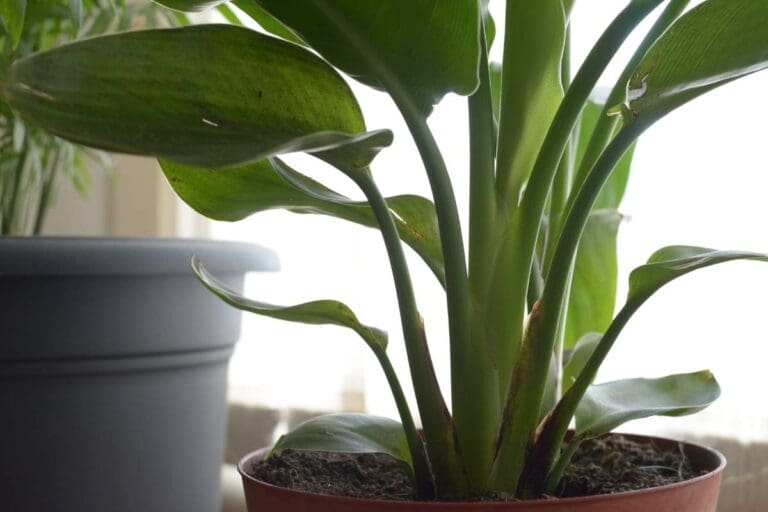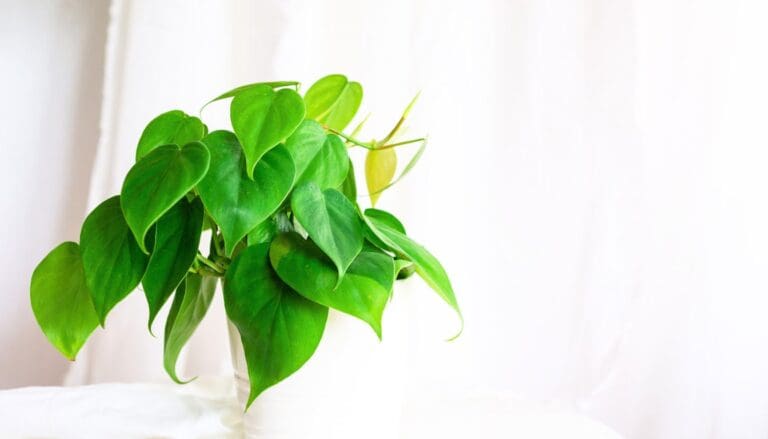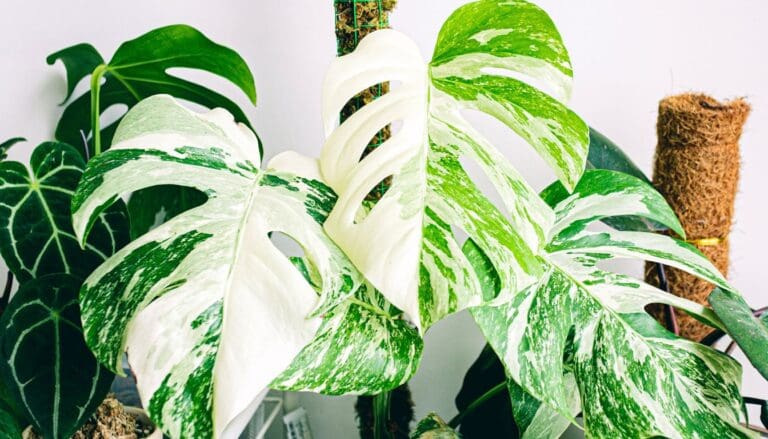How To Repot A Schefflera Plant? (A Step-by-Step Guide)
Repotting is one of the few essential care practices you must follow to keep your Schefflera thriving. However, many are clueless about the right procedure to repot this plant, which often leads to damage.
So, let’s find out how to repot the umbrella plant.
To repot the Schefflera plant:
- Choose a new pot, preferably 2 inches bigger than the previous one.
- Prepare a fresh potting mix by mixing 2 parts peat moss, 1 part perlite, and 1 part compost.
- Take the umbrella plant out of its pot and prune any damaged roots.
- Add fresh potting mix to the new pot and place the plant inside the pot.
- Add soil from all sides to secure the plant in its place.
- Water the plant and provide the ideal growing conditions.
In this article, I will discuss the various signs your umbrella plant will show if it needs repotting, the ideal time to repot and how to repot the Schefflera plant.

Please note: Simplify Plants is reader-supported. Some links in the post are affiliate links and I get a commission from purchases made through links in the post.
How do you know when to repot a Schefflera plant?
The most important thing to remember about repotting any plant is that you must repot it only when necessary.
Do not repot any plant whenever you feel like it because repotting is a procedure that puts a lot of stress on the plant.
Repotting a healthy, thriving plant will only risk the plant’s life.
Like humans, plants tend to grow comfortably in one condition, so unnecessary repotting can shock the plant.
You must watch for the several signs to understand whether your Schefflera needs repotting.
Let us discuss those signs below.
Stunted growth
When the Schefflera begins to grow root-bound, its growth gradually reduces.
The cramped roots have no more space to spread, which hampers their health.
You will notice the leaves yellowing and wilting, and the plant’s growth is gradually reducing in this situation.
Root-bound plant

If your Schefflera plant has become root-bound, you must repot the plant without delay.
A root-bound state occurs when the plant outgrows the existing pot, and the roots become so tangled up that it starts to absorb the soil, gradually filling up the entire pot by growing in a circular motion.
The root-bound plant reduces to grow further due to lack of space and nutrients and in such a situation, repotting to a bigger pot with fresh soil is the best solution.
Also read: Do Schefflera Plants Like To Be Root Bound? (+When To Repot)
Visible roots
Another sign that your Schefflera shows when it needs repotting is that the plant’s roots begin to show up on the soil surface.
When the Schefflera plant grows too big for the pot, the roots start to come upon the surface and come out of the drainage holes, sometimes blocking the holes and resulting in root rot.
Compact soil
When the plant does not get repotted for a long time, the soil becomes tight and compact.
This compact soil does not let air flow and obstructs water and nutrients from reaching the roots properly, reducing the plant’s growth.
Frequent dehydration
Another sign you need to watch out for is whether the Schefflera gets dehydrated quickly or not.
When the roots get too long and tangled up, it starts to soak up all the soil and nutrients, and thus when you water the plant, it does not reach the roots but flows out straight out of the drainage holes.
The roots fail to drink the water, dehydrating it very frequently.
Also read: How Much Water Does A Schefflera Plant Need? (Watering Guide)

Importance of repotting your Schefflera plant
Many houseplant owners are guilty of not repotting their plants.
If you want to keep your umbrella plant thriving and flourishing for a long time, you must repot the plant when needed.
Let us now discuss the several benefits of repotting your plant on time.
Provide the plant with more space for growth and roots expansion
Schefflera plants grow up to 5 feet as houseplants though outdoors in the wilds, can grow to a massive height.
Thus they are quite strong and tall houseplants that need appropriate space to grow and expand their roots.
If you keep the plant confined to a smaller pot, it will compromise the growth.
So as it grows, you must repot it in a bigger pot to give it more space and support its growth.
However, remember that the new pot you choose should not be more than 2 inches bigger than the existing pot.
An excessive big pot can also be damaging to the plant’s growth.
It adds fresh soil and nutrients to the plant
Plants growing in pots have limited access to nutrients, unlike those growing in the wild.
When the Schefflera grows in one pot for a long time, the soil loses its nutrients over time.
With regular watering, the nutrients get washed away, making the soil infertile over time.
In such conditions, even fertilizers fail to improve the soil.
After every few years, repotting the plant in the fresh potting mix helps the plant stay healthy and get all the essential nutrients.
Get rid of the diseased and damaged roots
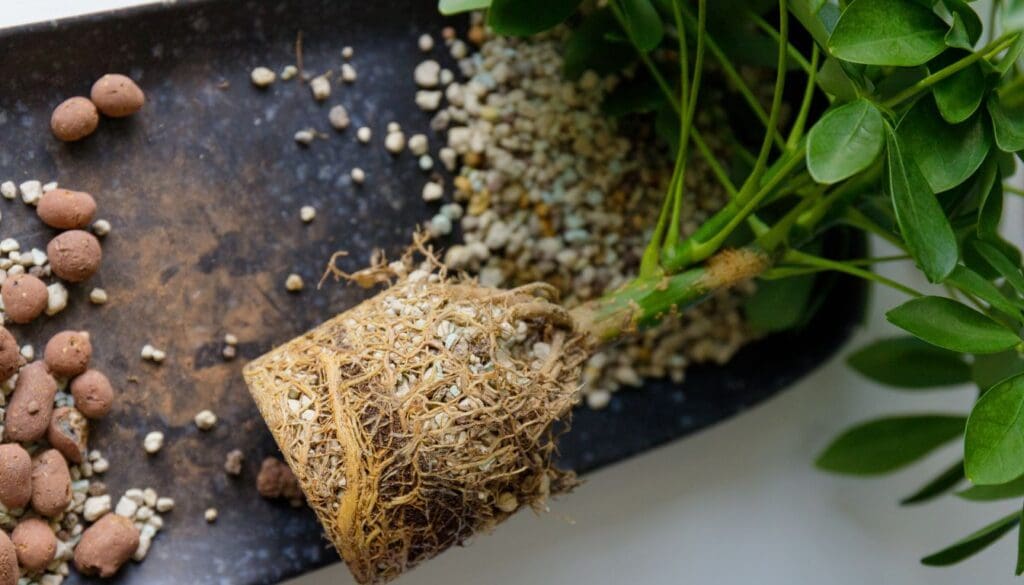
Repotting comes as the only solution when the roots get damaged or are affected by any disease.
Root rot is a disease that occurs in the roots when the soil stays soggy and overwatered for too long.
The wet roots fail to breathe due to a lack of oxygen, and pathogens attack the roots destroying the roots and ultimately killing the plant.
Some of the signs of root rot are:
- Wilted plant
- Yellowing of leaves
- Dropping leaves
- Foul-smelling soil
- Soggy soil
- Stunted growth
The only solution to a root rot situation is to trim the decayed roots, repot the plant in fresh soil, and water only when required.
Also read: Schefflera Pest Problems: Common Pests & Diseases+How To Fix
Overuse of fertilizers in the soil
Another extremely important benefit of repotting your Schefflera is to get rid of the salt accumulation due to fertilization.
Though fertilizers are very beneficial to any plant, overuse can equally harm the plant.
Excess fertilizer can lead to salt accumulation in the soil, burn the roots of the Schefflera, and soak up more water making the soil frequently dehydrated.
Some of the symptoms of over-fertilization are:
- Dry, dehydrated plant
- Yellowing leaves
- Wilting
- Weak plant
To clean the soil of this accumulated salt, changing the soil and using a fresh potting mix is the solution.
Also read: How Often Should I Fertilize My Schefflera? (+Ideal NPK Ratio)
When should you repot an umbrella plant?
You should repot the plants only during the growing season because, at that time, they stay active and strong, so it is easier for them to overcome the shock.
Repot your Schefflera during the spring and early summer season around February and March, when they are actively growing.
They can adjust themselves to the new condition easily during this phase.
Do not repot the Schefflera during fall or winter because its growth rate reduces and goes into dormancy.
During this time, the plant remains extremely sensitive and inactive, so adding unnecessary stress at this point will put the plant at great risk of survival.
However, if it is necessary to repot it in the fall or winter due to reasons like root diseases or root rot, you must do that with utmost precaution.
Tools you need to repot the Schefflera

As you prepare to begin the repotting process, it is best to keep all the necessary things near your hand so that you do not have to search back and forth between looking for equipment.
Once you arrange everything and have them ready, then start repotting.
This would ensure the repotting process is smooth and fast.
If you leave the uprooted plant midway without repotting it to look for things you need, your plant may suffer additional stress.
So let us see the things you need to arrange before beginning the repotting session:
- A new pot not bigger than 2 inches from the existing pot
- Good quality potting mix which is appropriate for Schefflera (Sand, peat moss, and perlite)
- Clean, sharp pruning shears
- Disinfectant
- Water
- A clean cloth or tub to keep the uprooted plant
How to repot the Schefflera plant?
You must follow the right procedure to repot your umbrella plant.
If you do it incorrectly or if the plant gets damaged in the process, that can be dangerous for the plant’s health.
Now let us begin discussing the correct way that you should follow to repot your Schefflera.
1. Choose the right pot

Choosing the right pot for your plant is the first and foremost step.
You need to keep a few things in mind when choosing the pot:
- Size: The size of the new pot should not be more than 2 inches from the existing pot. A pot that is too big for your plant will harm the growth because the roots will invest more energy in spreading themselves, reducing the plant’s growth. Also, an excessively big pot increases the chances of overwatering.
- Material: Along with the pot’s size, the pot’s material is equally important. Plastic and ceramic pots are non-porous, so they do not let air flow inside the soil. While terracotta pots are most recommended because they are porous, the chances of fungus growth are lowest because the soil does not stay soggy.
- Drainage holes: It is also extremely important that the pot has one or more drainage holes at the bottom. This hole lets the excess water flow outside the pot so that the soil does not stay soggy with water. Many fancy pots do not have drain holes at the bottom, which is very risky for the plants.
Also read: What Kind Of Pot Do You Use For Schefflera? (Size, Material & More)
2. Preparing the perfect soil mix
The next important step is to prepare the right soil mix for your Schefflera.
Before taking out the plant, you must do this, so the uprooted plant does not have to be left open for long.
Remember, umbrella plants like loose and well-draining soil but can retain moisture.
- For this, you take good quality potting soil.
- Then mix some perlite or sand with it. This helps in making the soil well-draining. This prevents the soil from getting too tight and compact and keeps it loose and airy.
- Then add some peat moss to it, which helps retain moisture.
- Add a handful of compost to this mix to add extra nutrients to the soil.
- Add a little bit of crushed charcoal or pine bark to this mix to keep the soil loose.
The perfect soil mix for your Schefflera is ready now, and you can go ahead with the next step.
Also read: What Kind Of Soil Does A Schefflera Plant Need? (+Ideal DIY Soil Mix)

3. Take the plant out from the existing pot
First, take the plant out from the existing pot to begin the repotting process.
You need to be very careful not to hurt or damage it to do this.
Turn the pot upside down and gently tap the bottom of the pot.
If you see that the plant is stuck, you can make it slightly moist and gently pull it.
Or you can use a knife to detach the rots tangled with the pot.
Remember not to pull the plant harshly, which can damage it badly.
4. Loosen the roots
Once the plant is out of the pot, you need to loosen up the roots, which are all tangled up.
Be careful not to damage the Schefflera roots, and gently shake off the root ball so that they find it easier to spread in the new pot.
Also, by doing this, you get rid of the old soil so it can get the nutrients from the fresh soil after repotting.
5. Place the Schefflera in the new pot
Now your Schefflera is ready to be planted in the new soil.
First, fill the bottom 4-5 inches of the pot with soil and tap the pot from the sides to close air gaps.
Then hold the plant’s root ball and carefully place it at the center of the pot and pour the fresh soil all around the plant.
Make sure the entire root structure stays under the soil surface.
Fill the pot to the rim with soil.
6. Water the plant after repotting

The first watering after repotting is important.
Water the Schefflera fully until you see the water coming out of the drain hole.
Also, do not forget to empty the cache or tray under the pot where the water accumulates.
This water, if not emptied, keeps the bottom of the pot soggy, which results in root rot.
7. Feed the newly potted plant
Schefflera plants are light feeders, so you do not have to feed them too often.
Feeding your Schefflera in the growing season with a balanced NPK 20:20:20 or a handful of compost is sufficient for this plant.
Remember not to fertilize right after repotting because the soil is already rich.
Overfertilization can burn your plant, so resume your fertilization schedule 2-3 months after you repot the plant.
Also, keep in mind that while fertilizing, do it directly on the soil and do not let it contact the leaves or stem of the plant.
Do not fertilize your Schefflera in the fall or winter, and always water the soil one day before feeding it.
Fertilizing in dry soil can result in root burn.
8. Take care of the newly potted Schefflera
Repotting puts the plant through a lot of stress, so once your repotting is over, make sure you give your plant the most suitable conditions.
Usually, the plant will take 4-5 days to overcome the shock.
Until then, it might look wilted and droopy.
Do not disturb your umbrella plant at this point, and let it adjust to its new surroundings.
Keep the newly repotted plant at a place that receives bright but indirect light and a lot of air circulation but no strong wind.
Give the plant a good amount of humidity, around 50-60%, with the help of humidifiers or pebble trays, and let the Schefflera bounce back on its own.
Final words

Repotting does not end with just moving the plant. It is a long process that continues even after the process is over. Your repotting is successful only after the plant bounces back from the stress and begins to flourish.
Remember, do not ignore repotting when the plant shows signs of stress.
It is an important part of your plant care that replenishes your umbrella plant with added nutrients to spread itself and grow.
However, remember a few basic rules of repotting. Do not repot unless necessary.
Repot only in the growing seasons of spring and summer. And post repotting give the plant time to heal and get comfortable in the new condition.
Reference: Wikipedia, Sciencedirect, Britannica, American Society for Horticultural Science, Schefflera taxonomic history.
Recommended Garden Supplies
| Product Image | Our Recommended Gardening Supplies | Check Offers! |
|---|---|---|
Top Top
Top
Top
Top
Top
Top
Top
Top | rePotme Houseplant and Tropical Classic Potting Soil Mix | Check Offer On Amazon |
 Top
Top
Top
Top
Top
Top
Top
Top | Espoma Organic Indoor Plant Food | Check Offer On Amazon |
 Top
Top
Top
Top
Top
Top
Top
Top | GooingTop LED Grow Light 6000K Full Spectrum Clip Plant Growing Lamp | Check Offer On Amazon |
 Top
Top
Top
Top
Top
Top
Top
Top | Soil Moisture Meter | Check Offer On Amazon |
 Top
Top
Top
Top
Top
Top
Top
Top | Govee Hygrometer Thermometer, Bluetooth Enabled! | Check Offer On Amazon |
 Top
Top | LEVOIT Humidifiers for Large Room(Best For Plants) | Check Offer On Amazon |
 Top
Top
Top
Top
Top
Top
Top
Top | Upgraded DIY Automatic Drip Irrigation Kit, 15 Potted Houseplants Support | Check Offer On Amazon |
 Top
Top
Top
Top
Top
Top
Top
Top | Stainless Steel Heavy Duty Gardening Tool Set | Check Offer On Amazon |
 Top
Top
Top
Top
Top
Top
Top
Top | Bonide Insecticidal Soap | Check Offer On Amazon |
 Top
Top
Top
Top
Top
Top
Top
Top | Bonide 32 oz Spray Neem Oil for Organic Gardening | Check Offer On Amazon |
 Top
Top
Top
Top
Top
Top
Top
Top | Garden Safe Fungicide | Check Offer On Amazon |



